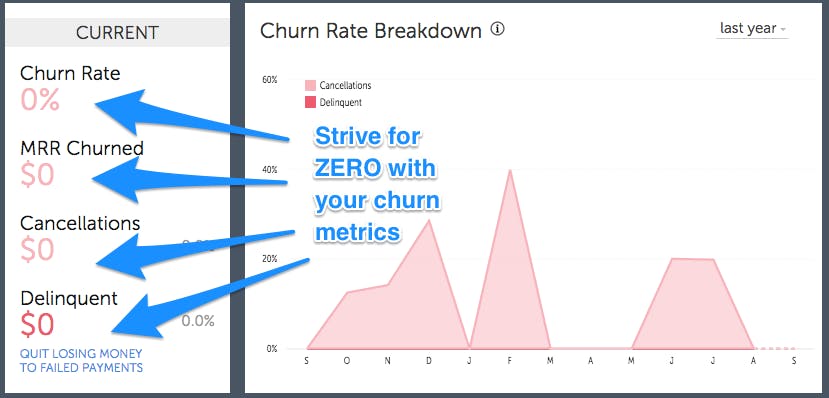User churn threatens your ability to generate recurring revenue. We walk through how to calculate it and ways you can tackle it to grow your SaaS business.
Churn is surely the greatest threat to your SaaS company's well-being.
Specifically, user churn threatens your ability to generate Monthly Recurring Revenue. Tracking and deciphering user churn allows your team to understand where value aligns with your product, which ultimately leads to increased users and revenue growth.
To help you join the league of the successful in SaaS, let’s walk through why user churn is so important, how to calculate it, and ways you can optimize user churn to grow your SaaS business.

What is user churn?
User churn is the occurrence of a customer no longer using your product/service and/or the subscription running out. Churn is not to be mistaken for cancellations. Just because your customer has cancelled does not mean that they have churned yet. In fact, the time between a user cancelling and officially churning out is an extraordinary area for opportunity. Officially, a churned customer is no longer able to use your product which means you have lost a stream of revenue.
Why you should care about user churn
Understanding and optimizing this metric to be as low as possible is extremely advantageous to your business.
"Not tracking user churn is like trying to eat a bowl of cheerios with a pitchfork; you won't retain much "
Why understanding your user churn is so important?
User churn's importance exists on the following levels:
Product should constantly be optimizing to reduce user churn rate:
The product team should focus on reducing user churn every month, quarter, and year. Churn is a direct reflection of the value of the product and features. When the product is great and aligned with a value metric the rate of cancellations should get to $0 monthly. A great way to keep churn in check is with a subscription reporting platform for product teams.
User churn directly affects your financial metrics (MRR/LTV/CAC):
If users are disappearing, then so is revenue. This is a critical metric for your finance team to pay attention to to ensure that recurring revenue, lifetime value, and acquisition costs are all where they should be in accordance to your company goals.
What do you include in user churn: Only the users leaving your business
Specifically, user churn is the sum of all the users that no longer have access to use your service. You can lose a user in one of three ways.
Actively cancelled + churned
This is a user who not only cancelled your service but did not renew within the grace period. The reason for this act may be that they didn’t like the product, too expensive, or even worse - a competitor offered something better.
Expired subscription
These are users who have let the subscription run its course and have chosen not to renew their service agreement. This is a very important segmentation because it tells you that something is lacking from your offering for them to not feel the pain of your product being no longer available. If a user lets their account expire then they could have just forgot (and you should have remarketed) or they didn't see any reason to keep using your product.
What should you not include in user churn - cancelled and delinquent users.
There is really no debate here when it comes to calculating user churn. A cancelled customer has not churned yet. There is still an opportunity there to retrieve the user and get them back to being active with your product. The same thing goes for delinquent users. These users have not churned and may just be having some credit card or other payment issues that can be resolved.
So you definitely do not want to include any of these aspects when you are tabulating your user churn metric. Simply stick to the users who no longer have access to log in with your service. Knowing who these users are will allow you to identify trends within that cohort so that you can optimize to keep others from following suit. Hey, maybe you'll even be able to get a churned customer back on board. Anything is possible when you accurately know what's going on in and out of your business.
Ok, so how do I calculate user churn?
The formula for calculating user churn is straightforward:
User churn (for a given period) = Total confirmed cancellations + total expired subscriptions
What are three ways you can reduce user churn?
User churn and user churn rate are constructed to help you optimize areas that are causing customers to leave your business. With that being said, here are a few of the main axes to hone in on that can help you reduce this number as much as possible.
- Fix your pricing: As we’ve found through our pricing strategy research at Price Intelligently that improper pricing heavily influences why folks churn out. After all, if you’re aligning your product to the value that a persona sees in the product, you shouldn't be losing those customers.
- Run Churn Loss Surveys and conversations: There are probably plenty of reasons people are churning from missing features to bad support experiences. You should have a product development process in place to identify these reasons. These surveys ask customers to choose the biggest reason they’re churning and the smallest reason they’re churning. These are powerful because they allow for you to pinpoint your biggest areas of opportunity.
- Increase your active users: This, by no stretch of the imagination, is easy to do. However, if you can manage to keep users active more consistently you will see a direct decrease in your churn numbers.




